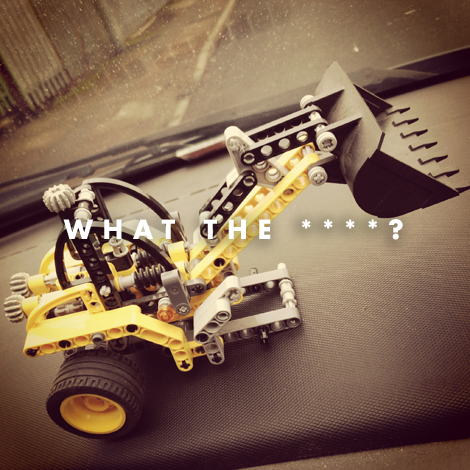
Last weekend I took a trip to the local recycling centre following a month long attempt to get the garden in some sort of shape for the spring growing season ahead.
In between sorting the scrap metal from the endless amounts of flotsam and jetsam, I had a few broken plastic plant pots to recycle in the bulk plastics skip.
While the ever present council operatives hovered, looking to skim off the good stuff, I looked down and saw the above poking out from the railings that separate you from whatever they do with this stuff. This struck me as a curious thing when considered in the context of design, manufacturing and sustainability.
Consider this: Lego. Age old childhood favourite. One that brings back evocative memories for almost everyone who as a child was lucky enough to have any. My own collection came from my much older brother and was extended on birthdays and Christmases. Now that has passed onto my own 8 year old son.
The eternally pleasurable sound of small hands swirling through a bucket of bricks is something I would imagine most designers and engineers recognise.
The click of 2 micron accurate ABS plastic components interconnecting with others is a treat, no matter what your age.
Conversely, the unpleasant feeling of teeth squeezing or nails bending to release those same bricks moments later, is also memorable. Essentially, we all like Lego. If you don’t, there’s something wrong with you.
But consider this in the context of sustainability. Lego is one of those toys that lasts.
The combination of brutally tight tolerances, high build quality and endless compatibility over the last 50 years means that many of the original products are still in circulation. I know our own bucket of bricks has teeth marks from nearly 50 years of use. And hopefully another generation or two hence.
For the company, this is a source of pride. Looking at Lego’s own annual report, you’ll find the following:
The ‘age span’ of LEGO bricks is longer than many other products. Often, LEGO products are passed on from one generation to another, which adds to their durability and value, and supports our Play Promise of ‘joy of building’ by extending the play value over time. However, it also raises issues such as a positive and sustainable end of life for our products.
Lego has formulated its approach to sustainable product design with the Design4Planet (D4P) initiative which is: “inspired by the concept of Cradle to Cradle) design, combined with the more traditional Life Cycle Assessment) view enabling us to learn more about materials, substances, and processes. We see some promising opportunities in this direction but also need to stress that it will likely be adjusted as we continue to become more knowledgeable about possibilities and limitations for us and our partners.”
Elsewhere in the report, Lego sets out the key five targets for its Design4Planet efforts.
- Materials Chemistry
- Environmental Certification
- Reduced and Compostable Print Packaging
- Design for Disassembly
- Return Solutions: Lego
Some of the company’s goals include zero product recalls (which they’ve met already) , improvement of employee safety, learning support for 101 million children by 2015 (they’re at 55 million now), 100% renewable energy sources to become entirely independent of fossil fuel sources (which has to be made much easier being headquartered in Denmark) and Zero waste – the company already has waste recycling across the board and is starting to implement this in its supply chain.According to the that ever slightly inaccurate source, Wikipedia, “eighteen bricks out of every million fail to meet the standard required.Lego factories recycle all but about 1 percent of their plastic waste from the manufacturing process every year. If the plastic cannot be re-used in Lego bricks, it is processed and sold on to industries that can make use of it”
So, it’s clear that the company is making great efforts and has a formulated plan in both the short and long term. But there’s a big but. The consumer has as much responsbility as the designer, as the manufacturing team, to ensure that the products they discard are disposed off properly – and here’s the perfect example of where things break down.
This little toy (to be honest, it’s half a toy) was discarded. It’s probably got another 20 years or so in it at least. The joy of Lego is in its endless variation, reuse and reimagination. Surely it could have been given to another child, donated to a charity outlet for sale (which gives double benefit). Instead, its dumped unceremoniously, awaits recycling which burns more energy. Just goes to show, even the most compelling sustainability schemes and theories breakdown at some point in the chain.
UPDATE: As asked by my good ol’ buddy Ralf Steck, I did indeed save it and its now washed and in the bucket of doom already






